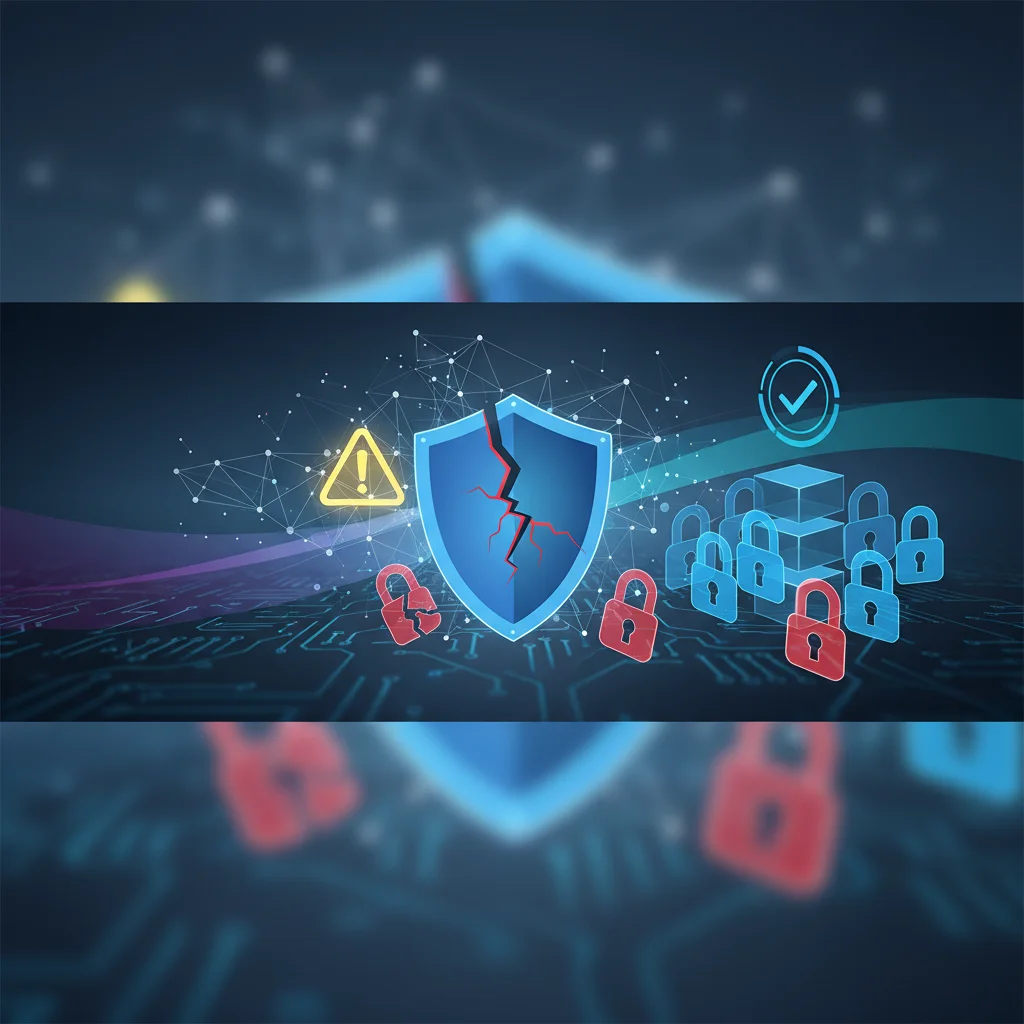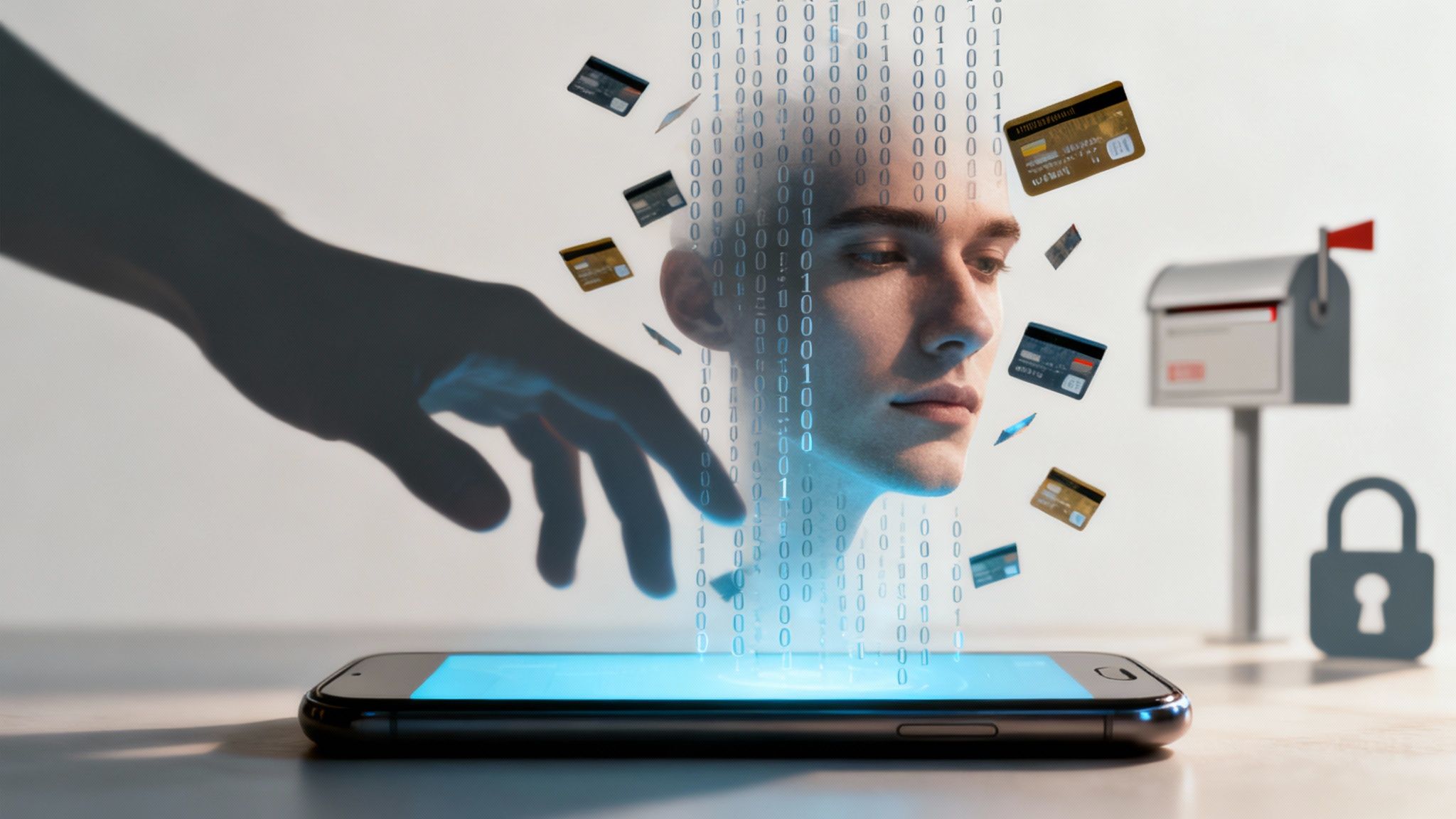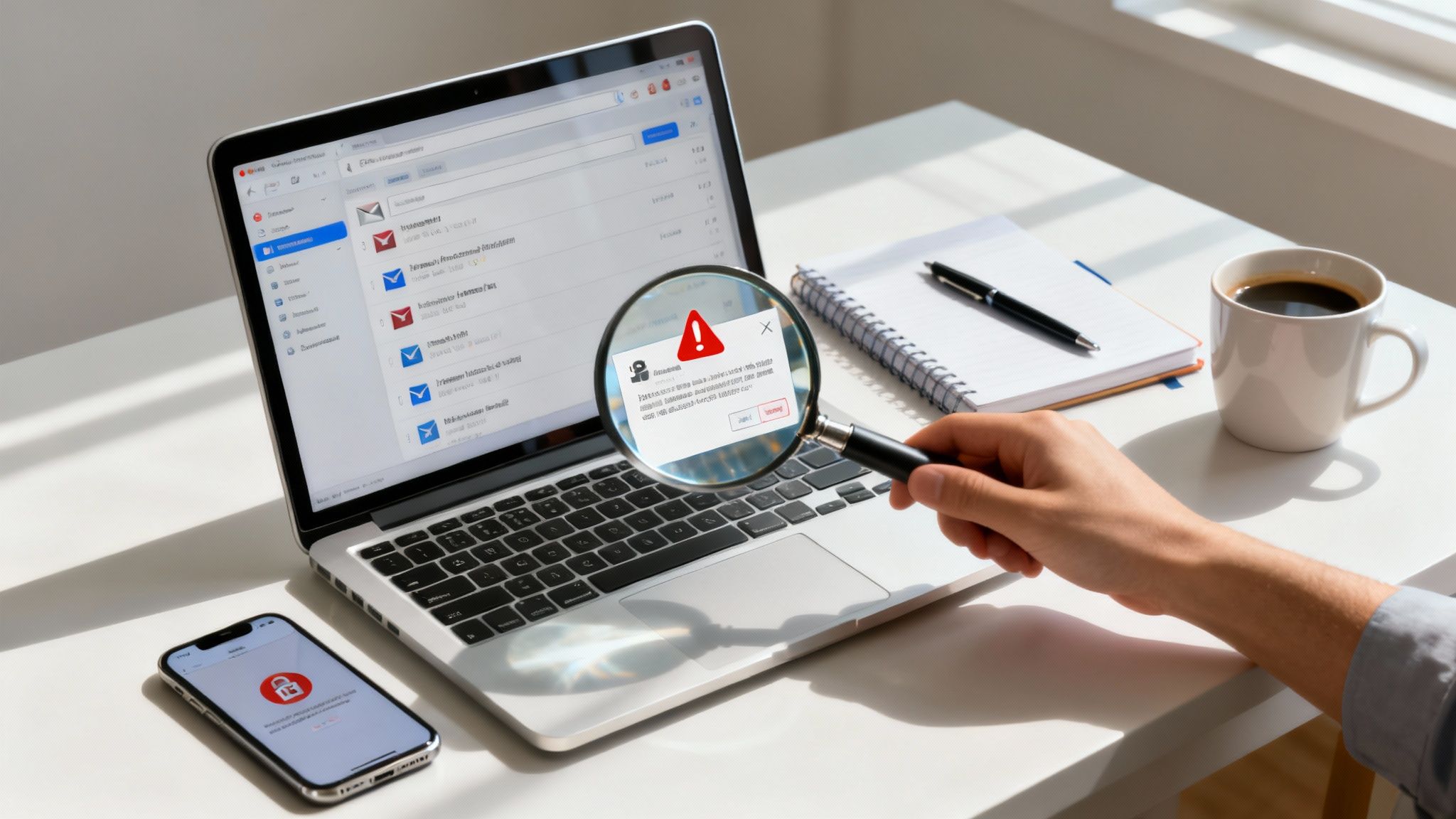· Digital Footprint Check · Content Marketing · 17 min read
What Is a Data Breach and How Do You Stop One
Understand what is a data breach with real-world examples. Learn proven strategies to protect your personal and business data from cyber threats.

At its core, a data breach is a digital robbery. It’s what happens when someone who isn’t authorized gets their hands on sensitive, confidential, or otherwise protected information. Instead of stealing physical goods, these criminals are after data.
Once stolen, this information can be used for all sorts of nasty business—like identity theft, being sold to the highest bidder on the dark web, or even held for ransom.
The Anatomy of a Data Breach

Picture a high-security bank vault. That vault is like a company’s database, and the valuables locked inside are your personal details. The burglar—in this case, a hacker—finds a weak spot, gets past the security systems, and walks away with everything. This is the essence of a data breach: unauthorized access that leads to data exposure.
It’s not always some sophisticated, high-tech assault, either. Sometimes, the “vault door” is simply left unlocked due to human error. This could be anything from a poorly configured server to an employee accidentally clicking a link in a phishing email.
No matter how it happens, the outcome is the same. Private information is now in the wrong hands.
To put it in simple terms, here’s a quick breakdown.
Data Breach at a Glance
| Concept | Simple Explanation |
|---|---|
| The Target | A company’s database or system holding valuable information. |
| The Asset | Your personal, financial, or medical data. |
| The Attacker | A cybercriminal (hacker) looking to steal that data. |
| The Method | Exploiting a security weakness, whether technical or human. |
| The Result | Your private information is stolen, exposed, or sold. |
This table makes it clear: a data breach is a direct line from a security failure to your personal information being compromised.
What Kind of Data Are They After?
Cybercriminals don’t just grab data at random; they target specific information because it’s valuable. This data can be sold, used to commit fraud, or even weaponized in future attacks.
Here’s what they’re usually looking for:
- Personally Identifiable Information (PII): Think full names, Social Security numbers, driver’s license numbers, and home addresses.
- Financial Information: This is the big one. Credit card numbers, bank account details, and logins for financial apps are goldmines.
- Protected Health Information (PHI): Medical records and health insurance details are incredibly valuable and heavily regulated.
- Credentials: Usernames and passwords. If they get these, they can often access a dozen other accounts where you’ve reused them.
A data breach isn’t just a technical problem; it’s a profound violation of trust. When a company fails to protect customer data, it breaks a fundamental promise of security, leading to consequences that extend far beyond financial loss.
This stolen information fuels a massive underground economy. Attackers will often bundle data from multiple breaches to build incredibly detailed profiles on people, making it frighteningly easy to commit identity theft or run highly targeted scams.
Every piece of exposed information adds to your risk, highlighting the hidden dangers of your digital footprint and how easily hackers can exploit it. With each breach, your vulnerability grows, which is why taking proactive steps to protect yourself is no longer optional.
How Data Breaches Actually Happen
Forget the fast-paced hacking scenes from the movies. Real-world data breaches rarely look like that. Instead, they often start with something almost boringly simple—like a deceptive email landing in an unsuspecting employee’s inbox.
Attackers are strategic. They don’t waste time trying to break down the strongest walls. Instead, they hunt for the weakest links, which are almost always human behavior and outdated software, to quietly slip into protected systems. A breach isn’t a single event; it’s a chain reaction, and understanding how it starts is the first step toward stopping it.

As you can see above, it often begins with a simple trick. A phishing attempt creates the first crack in the armor, giving attackers the foothold they need to exploit deeper software vulnerabilities and make off with your data.
The Human Element: Social Engineering and Phishing
The most common way attackers get in doesn’t involve cracking complex code; it involves tricking people. This tactic, known as social engineering, is all about manipulating human psychology to gain access to buildings, systems, or data.
Phishing is the undisputed champion of social engineering. Here’s the typical playbook:
- An attacker crafts an email that looks like it’s from a legitimate source—your bank, a service like Netflix, or even your company’s IT department.
- The message creates a sense of urgency, maybe claiming your account has been compromised or that you need to verify a recent transaction.
- You’re pushed to click a link that takes you to a fake login page. When you enter your username and password, you’ve just handed the keys to the kingdom directly to a criminal.
This simple act of deception works far more often than you’d think. In fact, a staggering 60% of all breaches involve tactics like phishing or the use of stolen credentials. It just goes to show how critical the human factor really is.
A locked door is useless if someone inside is tricked into opening it for a stranger. That’s the core principle of social engineering—it bypasses technical defenses by targeting human trust.
And these attacks are only getting more frequent and sophisticated. By 2025, cybercrime is projected to cost businesses a mind-boggling $10.5 trillion annually. With AI-powered phishing campaigns on the rise, it’s more important than ever to stay informed. You can dig deeper into these evolving cybersecurity statistics to see how they impact both businesses and individuals.
Technical Vulnerabilities: The Unlocked Digital Doors
While people are a favorite target, attackers are just as skilled at finding and exploiting technical flaws. Think of these vulnerabilities as unlocked backdoors into a company’s network, allowing criminals to slip in completely unnoticed.
Here are some of the go-to methods they use:
- Unpatched Software: When a developer finds a security hole in their software, they release an update, or “patch,” to fix it. If a company is slow to apply these updates, its systems are left wide open—it’s like leaving an invitation for attackers on the front door.
- Brute-Force Attacks: This method is less about finesse and more about raw power. Attackers use automated tools to try millions of username and password combinations until they hit the right one. This is exactly why using weak passwords like “123456” or “password” is so incredibly dangerous.
- Malware and Ransomware: Malicious software, or malware, can be delivered through a phishing email or an infected website. Once it’s on your device, it can do anything from logging your keystrokes to encrypting all your files and demanding a hefty ransom for their return (ransomware).
The Real-World Impact of a Data Breach
When a company’s digital vault is cracked open, the damage doesn’t stop at the initial theft. The fallout from a data breach creates a destructive ripple effect, spreading far and wide to harm both the people whose information was stolen and the organizations that were supposed to protect it.
It’s a digital disaster with very real, very tangible consequences.

For individuals, the blow is deeply personal and often lands fast. Stolen personal data is a direct pipeline to identity fraud. Before you know it, criminals could be opening credit cards, taking out loans, or even filing bogus tax returns in your name. This kicks off a long, stressful battle to reclaim your identity and repair your shattered credit.
Beyond the financial nightmare, there’s a profound loss of privacy and security. Just knowing your sensitive information is floating around in the wild can leave you with a lasting sense of vulnerability.
The Personal Price of Exposed Data
The damage to an individual often unfolds in painful stages, each one more disruptive than the last:
- Identity Theft: Using your Social Security number and other details, criminals can essentially become you, leading to a maze of financial and legal headaches.
- Financial Fraud: Your stolen credit card or bank information can be used to drain your accounts, often before you even realize anything is wrong.
- Reputation Damage: Exposed emails, private messages, or photos can be weaponized for blackmail or public humiliation.
Clawing your way back from these personal attacks takes a tremendous amount of time and effort. For a deeper dive into protecting yourself, check out our guide on the importance of conducting an online digital footprint check.
The Staggering Cost for Businesses
For any business, the consequences of a data breach are complex, layered, and incredibly expensive. The initial costs to contain the damage are just the tip of the iceberg. The long-term fallout can threaten a company’s very existence.
The financial bleeding comes from all directions. There are massive regulatory fines from laws like GDPR and CCPA that can run into the millions. Then you have the costs of notifying every affected customer, providing credit monitoring services, and paying for forensic teams to figure out how bad the breach really was.
But the biggest cost isn’t always something you can quantify on a spreadsheet.
The global average cost of a data breach recently hit $4.45 million. That number is already eye-watering, but in the United States, the average skyrockets to an all-time high of $9.48 million, thanks to steep regulatory penalties and higher detection costs. On top of that, it takes companies an average of 277 days just to identify and contain a breach, showing just how tough these incidents are to manage.
Ultimately, the operational downtime, the endless legal battles, and a permanently tarnished brand can cripple an organization for years, if not forever.
Learning from Recent High-Profile Breaches
Knowing the dictionary definition of a data breach is one thing. Watching a real one unfold is something else entirely. To really get a handle on the scale of these threats, you have to look at how these digital heists go down in the real world.
High-profile breaches are powerful, if unfortunate, cautionary tales. By picking them apart, we can see the specific—and often preventable—security gaps that lead straight to disaster. We move past abstract ideas and see the real consequences for companies and their customers. Each case tells a story of an attacker’s methods, the value of the stolen data, and the long, painful aftermath.
The Anatomy of an Attack
Recent breaches have laid bare just how vulnerable companies in every industry are, often because of surprisingly simple security mistakes.
Take the Mars Hydro breach in February 2025. A staggering 2.7 billion records were exposed, leaking sensitive data like Wi-Fi passwords and IP addresses. The cause? A misconfigured database left wide open without a password. It was a basic but catastrophic error.
Just a month later, the Oracle Cloud breach in March 2025 compromised over 6 million records and hit more than 140,000 tenants. This one put a spotlight on the huge risks that come with relying on third-party service providers. As these events show, one single weak link can cause an unbelievable amount of damage. You can get a deeper sense of the fallout by reading more about the impact of these recent breaches.
These examples hammer home a critical point: attackers don’t need to be criminal masterminds. They just need to find one unlocked door.
A data breach is rarely a single, dramatic event. It’s a cascade of small failures—a missed software update, a weak password, a single click on a malicious link—that combine to create a catastrophe.
Common Threads in Modern Breaches
While the details of every breach are different, a few common themes keep popping up. If you can spot these patterns, you can get a much better idea of where the biggest risks are and where to focus your defenses.
Here are a few of the usual suspects in major security incidents:
- Human Error: An employee getting fooled by a clever phishing email is still one of the most reliable ways for attackers to get their foot in the door.
- Unpatched Vulnerabilities: Companies that drag their feet on security updates are basically leaving their systems exposed to well-known exploits that hackers are actively hunting for.
- Third-Party Risk: The breach doesn’t always start with the main target. It often comes from a connected vendor or partner who has weaker security.
- Credential Compromise: Why break in when you can just log in? Attackers use stolen usernames and passwords from previous breaches to walk right through the front door.
By learning from the mistakes of others, we can do a better job of preparing ourselves. Every headline-grabbing breach is a free lesson in what not to do, reminding us that proactive security is always better than reactive damage control.
Actionable Strategies to Prevent Data Breaches

Knowing how a data breach happens is one thing. Actually stopping one requires deliberate, proactive steps.
While no defense is ever 100% foolproof, layering your security measures makes you a far less attractive target. Think of these strategies as the digital equivalent of deadbolts, security cameras, and reinforced doors for your most valuable information.
For individuals and businesses alike, solid security is built on a foundation of consistent, basic habits. These aren’t overly complex or expensive solutions—they’re the essential practices that shut down the most common entry points attackers love to exploit. The goal is to make breaking in so difficult that they simply move on to easier prey.
Fortify Your First Line of Defense
Your accounts are only as strong as the passwords guarding them. Using weak or reused passwords is like leaving your front door key under the welcome mat; it’s the first place a thief is going to look. A strong password policy is non-negotiable.
Just as critical is multi-factor authentication (MFA). MFA is like a second lock on the door. Even if a criminal manages to steal your password (the key), they still can’t get inside without the second code from your phone or another device. Enabling MFA is one of the single most effective things you can do to block unauthorized access.
Maintain Digital Hygiene
Attackers love to exploit known software vulnerabilities. Developers are constantly releasing updates, or “patches,” to fix weaknesses they discover in their code. If you fail to install these updates, you’re leaving your digital doors wide open to well-known attacks.
A disciplined approach to digital maintenance is essential.
- Regular Software Updates: Turn on automatic updates for your operating system, web browser, and other applications. This ensures critical security patches are applied the moment they’re available.
- Data Encryption: Encrypting your sensitive files means that even if someone steals them, the data is just unreadable gibberish without the specific decryption key. Use it for data at rest (on your hard drive) and in transit (when you send it over a network).
- Limit Access: Stick to the principle of least privilege. Any employee or application should only have access to the bare minimum of data and systems required to do their job. Nothing more.
Prevention isn’t a “set it and forget it” task—it’s an ongoing process. A strong security posture comes from a culture of vigilance, where every single person understands their role in protecting sensitive information.
Even with the best defenses, companies have to be prepared for the worst. That’s why it’s so important to start building a resilient data breach response plan before an incident happens. A good plan ensures you can react quickly to contain the damage and start the recovery process immediately.
Finally, never underestimate the power of training. The human element is often the weakest link in the security chain. In fact, 74% of breaches involve people, whether through simple mistakes or falling for social engineering scams.
Regular security awareness training teaches employees how to spot phishing emails and follow best practices. For everyone—from individuals to large companies—learning how to secure your digital footprint is a fundamental part of any modern defensive strategy.
Your Questions About Data Breaches, Answered
When you find out your personal info might have been caught up in a data breach, it’s easy to feel overwhelmed and unsure of what to do next. Let’s cut through the noise and tackle some of the most common questions people have.
I Think My Data Was Breached. What’s the Very First Thing I Should Do?
If you get an alert or just have a bad feeling that your data was compromised, your first move is damage control. Don’t wait. The most important thing you can do is immediately change the password for the account in question.
And if you’re like most people and have reused that password on other sites, you have to change those, too. This stops a single breach from turning into a domino effect that compromises your entire digital life. While you’re at it, enable multi-factor authentication (MFA) everywhere you can. It’s a huge roadblock for anyone trying to get in, even if they have your password.
Once you’ve locked things down, scan the account for anything that looks off—logins from weird places, changes to your profile you didn’t make, or strange purchases. To be extra safe, think about placing a fraud alert or a credit freeze with the major credit bureaus. That will make it much harder for criminals to open new lines of credit in your name.
Are Small Businesses Really Targets for Big Data Breaches?
Absolutely. In fact, they’re often preferred targets. The massive corporate hacks are the ones that make the news, but cybercriminals see small and medium-sized businesses (SMBs) as the path of least resistance.
The thinking is pretty simple: smaller businesses likely have smaller budgets for cybersecurity and less sophisticated defenses, making them “soft targets.” For a small business, a successful attack can be a knockout blow. The cost of cleaning up the mess, paying potential fines, and rebuilding a shattered reputation is often too much to bear.
Don’t ever think you’re too small to be a target. For cybercriminals, it’s a numbers game. They’re looking for an easy win, and an under-protected business of any size is a perfect opportunity.
This is exactly why every business, no matter its size, needs to get the security fundamentals right, from training employees to keeping software updated.
What’s the Difference Between a Data Breach and a Data Leak?
The real difference comes down to one word: intent.
A data breach is an attack. It’s a deliberate, hostile act where criminals actively find and exploit a weakness to break into a system and steal information. Think of it like a burglar picking a lock to get into a house.
On the other hand, a data leak is an accident. It’s the unintentional exposure of sensitive data. No one broke in; the information was simply left unsecured by mistake.
Common ways data leaks happen include:
- A database is misconfigured and left wide open on the internet without a password.
- An employee accidentally sends a spreadsheet full of customer data to the wrong email address.
- Someone tosses physical documents with sensitive info into a public dumpster instead of shredding them.
Even though one is malicious and the other is accidental, the end result is the same: your private information is out in the open.
Will Using a VPN Protect Me from Data Breaches?
A VPN (Virtual Private Network) is a fantastic tool for privacy, but it won’t stop a data breach at a company you use. Let me explain. A VPN’s job is to encrypt your internet connection, which is like sending your data through a secure, private tunnel. This is super important when you’re on public Wi-Fi, as it prevents anyone from snooping on what you’re doing.
But a VPN only protects your data while it’s in transit from your device to its destination. It can’t do anything to protect the data that a company has already stored on its own servers. If that company gets hacked, the information you gave them—your name, email, password, etc.—is still vulnerable.
So, while a VPN is great for protecting your connection, it can’t patch a security hole on someone else’s server.
Are you worried that your personal information is already exposed from a past data breach? The first step to locking down your digital life is knowing what’s out there. Digital Footprint Check dives into the web and the dark web to find out where your data has been compromised, putting you back in control. Discover your exposure and protect your identity today at https://digitalfootprintcheck.com.



